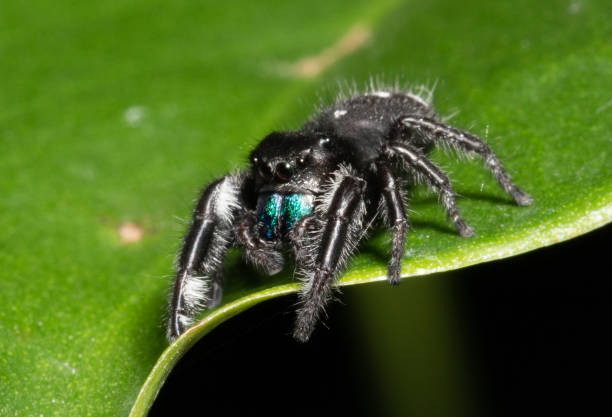Table of Contents
Introduction
The Jumping Spider (Phidippus regius) is truly one of the most delightful little arachnids out there. It’s not just another tiny creature scurrying through the grass; this little spider has captivated scientists, nature enthusiasts, and even pet owners alike. With its vibrant colors and quick movements, it’s hard not to notice it. Its inquisitive nature really draws people in.
Phidippus regius isn’t what most folks picture when they think of spiders. Rather than being creepy, many find this spider to be quite adorable and even a bit friendly. That’s not a typical perspective on arachnids! This spider is famous for its incredible jumping abilities, sharp vision, and unique behaviors. It certainly stands out in the diverse Salticidae family, which is known for its jumping spiders.
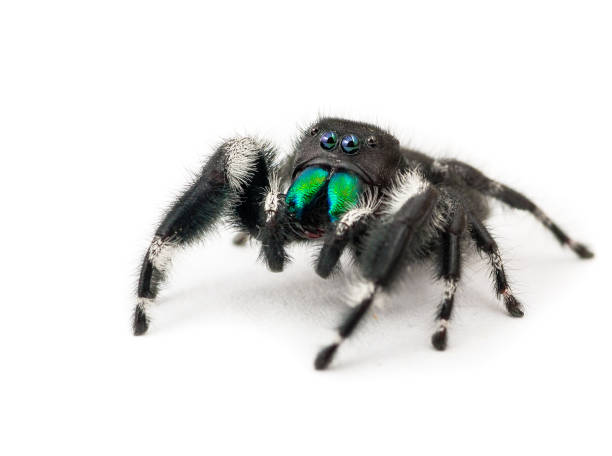
Scientific Classification
- Common Name: Regal Jumping Spider
- Scientific Name: Phidippus regius
- Kingdom: Animalia
- Phylum: Arthropoda
- Class: Arachnida
- Order: Araneae
- Family: Salticidae
- Genus: Phidippus
- Species: regius
Description
Phidippus regius, commonly known as the Regal Jumping Spider, stands out as one of the largest and most colorful jumping spiders found in North America. Its prominent, forward-facing eyes not only give it a charming appearance but also provide it with exceptional vision.
Key Physical Traits:
- Size: Adult females can reach up to 18–22 mm, while males are slightly smaller at 12–15 mm.
- Coloration: The species shows sexual dimorphism:
- Males are generally black with bold white spots on the abdomen and legs. Their iridescent chelicerae (mouthparts) shimmer with greens or purples.
- Females show many colors—gray, orange, or peach. They also have different patterns on their abdomens.
- Jumping spiders have eight eyes. Their two large central eyes provide excellent vision and a wide field of view.
- Body Type: They are compact and fuzzy. Their stout build helps them hunt well and climb easily.
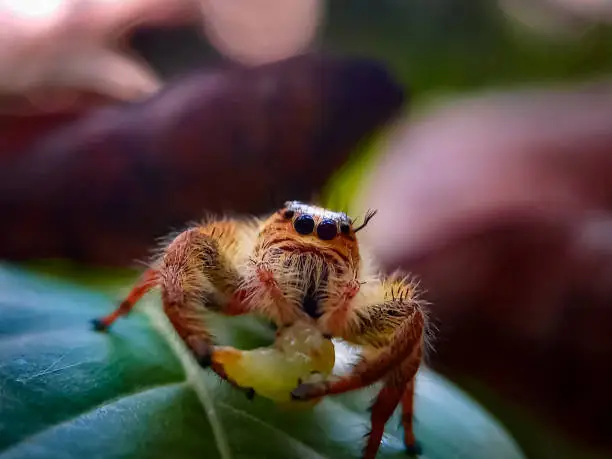
Distribution
The Regal Jumping Spider is found in the southeastern United States, mainly in:
- Florida
- Georgia
- South Carolina
- Alabama
- Texas
It is also found in parts of the Caribbean, including the Bahamas and Greater Antilles.
Captive-bred exotic pets are now popular worldwide. Many arachnid fans keep them in vivariums.
Habitat
Phidippus regius might be on the smaller side, but it sure knows how to adapt! This little spider can be found in a variety of habitats.
Common Habitats:
Shrubs and Low Vegetation: These spots are perfect for sneaking up on prey and staying out of sight from predators.
Open Fields and Grasslands: They love basking in the sun where food is abundant.
Forest Edges and Clearings: These areas provide a nice mix of cover and hunting grounds.
Urban Gardens and Fences: You’ll often spot them hanging out on wooden fences, garden furniture, and sheds.
Interestingly, they don’t use their silk to catch their meals. Instead, they create silk retreats for molting, laying eggs, or just taking a break.
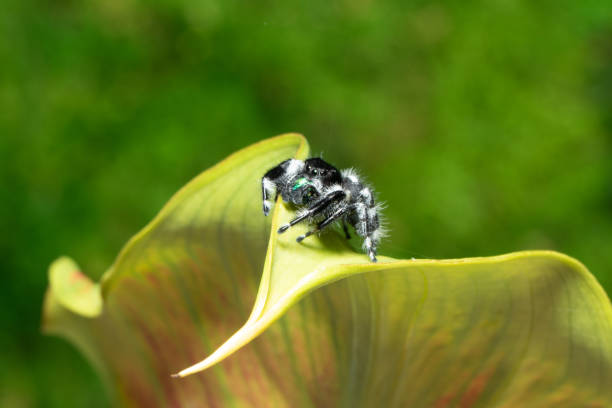
Diet
The Regal Jumping Spider is a meat-eater with a surprisingly varied diet.
Main Prey:
- Flies
- Moths
- Crickets
- Small beetles
- Other spiders
- Occasionally small ants
These spiders do not spin webs to capture prey. Instead, they rely on their stealth, speed, and excellent vision. A typical hunt starts with a slow stalk. Then, there’s a quick leap to catch the prey. Finally, it secures the catch with a venomous bite.
They also use a silk tether—like a safety line—during their jumps to avoid fatal falls.
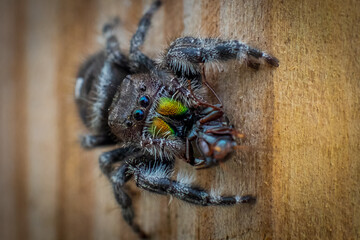
Behavior
Solitary but Curious:
Phidippus regius is generally solitary but exhibits a notable curiosity—especially in captivity. Observers have seen them turn their heads. They “watch” humans and objects. They also react to movement and reflections.
Diurnal:
They hunt during the day and depend on sight. This daytime activity is vital for their survival.
Non-aggressive:
Unlike more aggressive spiders, P. regius is shy around larger animals and humans. If threatened, it will often retreat rather than bite.
Lifespan
The lifespan of a Regal Jumping Spider varies between 1 to 2 years, depending on:
- Environmental conditions
- Gender (females often live longer)
- Access to food and protection
In captivity, with proper care, they can sometimes live up to 3 years.
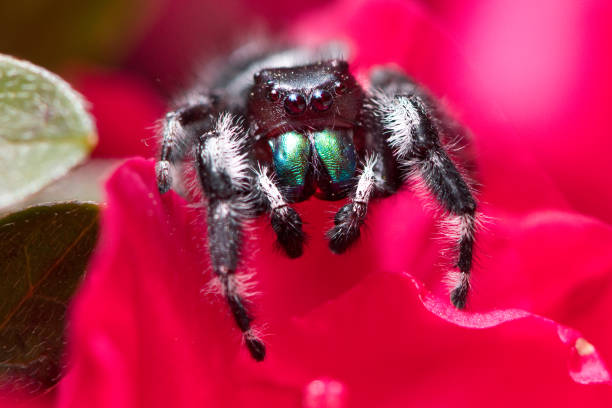
Reproduction and Lifecycle
Courtship:
Males perform intricate visual displays, involving:
- Raising their front legs
- Waving them rhythmically
- Showcasing their iridescent chelicerae
If the female is receptive, she will allow him to approach. If not, the male risks being attacked.
Mating:
After mating, the male uses his pedipalps. These are special parts that help him transfer sperm into the female’s genital opening.
Egg-Laying:
- Females lay 30–170 eggs inside a silk cocoon, usually hidden under bark or within a silk retreat.
- She remains to guard the eggs until hatching, which can take 2–4 weeks.
Spiderlings:
- Hatchlings disperse soon after emerging.
- They molt several times as they grow, eventually reaching full adult size.
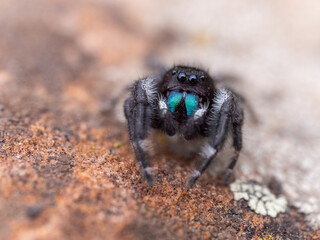
Predators
Despite being hunters themselves, Phidippus regius is also prey for several animals.
Common Predators:
- Birds (especially small insectivorous species)
- Larger spiders
- Lizards
- Wasps
- Small mammals
Their quick reflexes, great vision, and camouflaged colors offer some protection. Still, nature is tough.
Nest and Shelter
Rather than webs, P. regius spins silk retreats or hammocks.
Used For:
- Resting at night
- Molting
- Laying eggs
- Avoiding extreme heat or predators
These nests are typically tucked under bark, leaves, or behind rocks and structures. They are rarely exposed in open view.
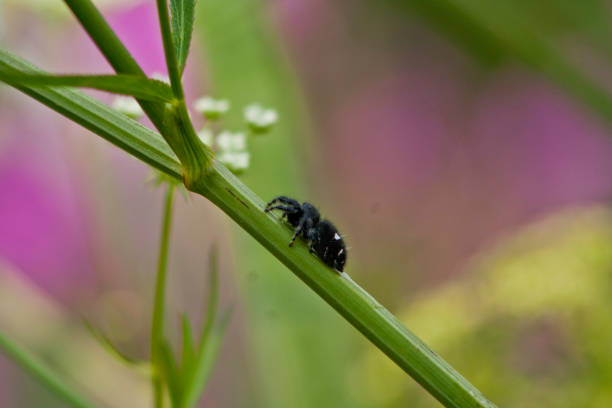
Adaptations
The evolutionary toolkit of this spider is impressive.
Key Adaptations:
- Jumping Ability: It uses strong hind legs and internal pressure to jump up to 50 times its length.
- Great Vision: Their two big front eyes provide almost a 360° view. This helps them see motion, depth, and color.
- Silk Safety Line: A dragline made of silk is tied to the takeoff point. It helps jumpers avoid falls and return to safety quickly.
- Camouflage: Their colors help them blend in with tree bark, leaves, and city surfaces.
- Visual Communication: Bright colors and leg movements attract mates and scare off competitors.
Mating Season and Breeding
Timing:
The mating season usually happens in spring and early summer. This is when temperatures go up and prey is easier to find.
Behavioral Traits:
- Males roam widely during this period searching for females.
- Females may mate more than once but often become aggressive post-mating.
Breeding success depends on three main factors: courtship performance, physical health, and safe nesting sites.
Interesting Facts
- They Can See Color: Jumping spiders can detect red, green, blue, and UV light—a rare trait among arachnids.
- Pet Trade Popularity: Their lively spirit makes them popular exotic pets for hobbyists.
- No Webs for Prey: They don’t spin webs to trap food—this makes them more like cats of the spider world.
- Mini-Brains, Major Smarts: Studies show that jumping spiders can solve problems. They recognize prey using their visual memory.
- Male Display Resembles a Dance: Courtship dances are detailed and rhythmic. They look like little performance art rituals.
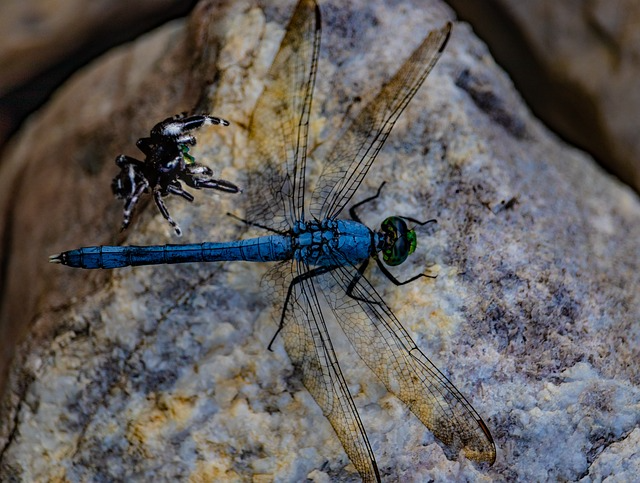
Conservation Status
Currently, Phidippus regius is not considered endangered or threatened. Their adaptability, wide range, and growing presence in captivity contribute to population stability.
However, like many small creatures, they face localized threats from:
- Habitat destruction
- Pesticides
- Climate change
Conservationists promote keeping natural green spaces and using fewer pesticides. This helps support healthy jumping spider populations.
Final Thoughts
The Regal Jumping Spider, known scientifically as Phidippus regius, really catches the eye with its vibrant colors and clever behaviors. Despite its small size, it has some pretty unique survival tactics that make it truly fascinating. Whether you spot it in the wild, get a closer look with a macro lens, or even decide to keep one as an exotic pet, this spider offers a glimpse into the intricate world of invertebrate life.

